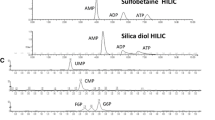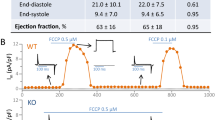Abstract
The muscle-specific ubiquitin ligases MuRF1, MuRF2, MuRF3 have been reported to have overlapping substrate specificities, interacting with each other as well as proteins involved in metabolism and cardiac function. In the heart, all three MuRF family proteins have proven critical to cardiac responses to ischemia and heart failure. The non-targeted metabolomics analysis of MuRF1−/−, MuRF2−/−, and MuRF3−/− hearts was initiated to investigate the hypothesis that MuRF1, MuRF2, and MuRF3 have a similarly altered metabolome, representing alterations in overlapping metabolic processes. Ventricular tissue was flash frozen and quantitatively analyzed by GC/MS using a library built upon the Fiehn GC/MS Metabolomics RTL Library. Non-targeted metabolomic analysis identified significant differences (via VIP statistical analysis) in taurine, myoinositol, and stearic acid for the three MuRF−/− phenotypes relative to their matched controls. Moreover, pathway enrichment analysis demonstrated that MuRF1−/− had significant changes in metabolite(s) involved in taurine metabolism and primary acid biosynthesis while MuRF2−/− had changes associated with ascorbic acid/aldarate metabolism (via VIP and t test analysis vs. sibling-matched wildtype controls). By identifying the functional metabolic consequences of MuRF1, MuRF2, and MuRF3 in the intact heart, non-targeted metabolomics analysis discovered common pathways functionally affected by cardiac MuRF family proteins in vivo. These novel metabolomics findings will aid in guiding the molecular studies delineating the mechanisms that MuRF family proteins regulate metabolic pathways. Understanding these mechanism is an important key to understanding MuRF family proteins’ protective effects on the heart during cardiac disease.



Similar content being viewed by others
Abbreviations
- E3:
-
Ubiquitin ligase
- MuRF1(2,3):
-
Muscle ring finger-1(2,3)
- VIP:
-
Variable importance in projection
- PCA:
-
Principal components analysis
- PLS-DA:
-
Partial least squares discriminant analysis
References
Anderson, K. E., Dart, A. M., & Woodcock, E. A. (1995). Inositol phosphate release and metabolism during myocardial ischemia and reperfusion in rat heart. Circulation Research, 76, 261–268.
Azuma, J., et al. (1982). Taurine for treatment of congestive heart failure. International Journal of Cardiology, 2, 303–304.
Azuma, J., et al. (1983). Therapy of congestive heart failure with orally administered taurine. Clinical Therapeutics, 5, 398–408.
Azuma, J., et al. (1985). Therapeutic effect of taurine in congestive heart failure: a double-blind crossover trial. Clinical Cardiology, 8, 276–282.
Bain, J. R., Stevens, R. D., Wenner, B. R., Ilkayeva, O., Muoio, D. M., & Newgard, C. B. (2009). Metabolomics applied to diabetes research: Moving from information to knowledge. Diabetes, 58, 2429–2443. doi:10.2337/db09-0580.
Berridge, M. J. (1993). Inositol trisphosphate and calcium signalling. Nature, 361, 315–325. doi:10.1038/361315a0.
Bodine, S. C., et al. (2001). Identification of ubiquitin ligases required for skeletal muscle atrophy. Science, 294, 1704–1708. doi:10.1126/science.1065874.
Centner, T., et al. (2001). Identification of muscle specific ring finger proteins as potential regulators of the titin kinase domain. Journal of Molecular Biology, 306, 717–726. doi:10.1006/jmbi.2001.4448.
Crass, M. F, 3rd, & Lombardini, J. B. (1977). Loss of cardiac muscle taurine after acute left ventricular ischemia. Life Sciences, 21, 951–958.
El Idrissi, A., Okeke, E., Yan, X., Sidime, F., & Neuwirth, L. S. (2013). Taurine regulation of blood pressure and vasoactivity. Advances in Experimental Medicine and Biology, 775, 407–425. doi:10.1007/978-1-4614-6130-2_31.
Fiehn, O., et al. (2008). Quality control for plant metabolomics: Reporting MSI-compliant studies. Plant journal, 53, 691–704. doi:10.1111/j.1365-313X.2007.03387.x.
Fielitz, J., et al. (2007a). Myosin accumulation and striated muscle myopathy result from the loss of muscle RING finger 1 and 3. The Journal of Clinical Investigation, 117, 2486–2495. doi:10.1172/JCI32827.
Fielitz, J., et al. (2007b). Loss of muscle-specific RING-finger 3 predisposes the heart to cardiac rupture after myocardial infarction. Proceedings of the National Academy of Sciences United States of America, 104, 4377–4382. doi:10.1073/pnas.0611726104.
Frazier, D. M., et al. (2006). The tandem mass spectrometry newborn screening experience in North Carolina: 1997–2005. Journal of Inherited Metabolic Disease, 29, 76–85. doi:10.1007/s10545-006-0228-9.
Gonzalez-Loyola, A., & Barba, I. (2010). Mitochondrial metabolism revisited: A route to cardioprotection. Cardiovascular Research, 88, 209–210. doi:10.1093/cvr/cvq258.
Guaiquil, V. H., Golde, D. W., Beckles, D. L., Mascareno, E. J., & Siddiqui, M. A. (2004). Vitamin C inhibits hypoxia-induced damage and apoptotic signaling pathways in cardiomyocytes and ischemic hearts. Free Radical Biology and Medicine, 37, 1419–1429. doi:10.1016/j.freeradbiomed.2004.06.041.
Halket, J. M., Przyborowska, A., Stein, S. E., Mallard, W. G., Down, S., & Chalmers, R. A. (1999). Deconvolution gas chromatography/mass spectrometry of urinary organic acids–potential for pattern recognition and automated identification of metabolic disorders. Rapid Communications in Mass Spectrometry, 13, 279–284. doi:10.1002/(SICI)1097-0231(19990228)13:4<279:AID-RCM478>3.0.CO;2-I.
Huang, J., et al. (2001). Dehydroascorbic acid, a blood-brain barrier transportable form of vitamin C, mediates potent cerebroprotection in experimental stroke. Proceedings of the National Academy of Sciences United States of America, 98, 11720–11724. doi:10.1073/pnas.171325998.
Huxtable, R., & Bressler, R. (1974). Taurine concentrations in congestive heart failure. Science, 184, 1187–1188.
Ito, T., Schaffer, S., & Azuma, J. (2014). The effect of taurine on chronic heart failure: Actions of taurine against catecholamine and angiotensin II. Amino Acids, 46, 111–119. doi:10.1007/s00726-013-1507-z.
Kim, O. Y., Jung, Y. S., Cho, Y., Chung, J. H., Hwang, G. S., & Shin, M. J. (2013). Altered heart and kidney phospholipid fatty acid composition are associated with cardiac hypertrophy in hypertensive rats. Clinical Biochemistry, 46, 1111–1117. doi:10.1016/j.clinbiochem.2013.04.008.
Kind, T., et al. (2009). FiehnLib: Mass spectral and retention index libraries for metabolomics based on quadrupole and time-of-flight gas chromatography/mass spectrometry. Analytical Chemistry, 81, 10038–10048. doi:10.1021/ac9019522.
Kopka, J., Schauer, N., Krueger, S., Birkemeyer, C., Usadel, B., Bergmueller, E., et al. (2005). GMD@CSB.DB: The golm metabolome database. Bioinformatics, 21(8), 1635–1638.
Li, C., et al. (2005). Taurine may prevent diabetic rats from developing cardiomyopathy also by downregulating angiotensin II type2 receptor expression. Cardiovascular Drugs and Therapy, 19, 105–112. doi:10.1007/s10557-005-0443-x.
Li, H. H., et al. (2011). The ubiquitin ligase MuRF1 protects against cardiac ischemia/reperfusion injury by its proteasome-dependent degradation of phospho-c-Jun. American Journal of Pathology, 178, 1043–1058. doi:10.1016/j.ajpath.2010.11.049.
Lopaschuk, G. D., Ussher, J. R., Folmes, C. D., Jaswal, J. S., & Stanley, W. C. (2010). Myocardial fatty acid metabolism in health and disease. Physiological Reviews, 90, 207–258. doi:10.1152/physrev.00015.2009.
Lopaschuk, G. D., Wambolt, R. B., & Barr, R. L. (1993). An imbalance between glycolysis and glucose oxidation is a possible explanation for the detrimental effects of high levels of fatty acids during aerobic reperfusion of ischemic hearts. Journal of Pharmacology and Experimental Therapeutics, 264, 135–144.
Mallard, W. G., Reed J. (1997). Automated Mass Spectral Deconvolution and Identification System: AMDIS User Guide. National Institute of Standards and Technology, US Department of Commerce iv, 58. http://chemdata.nist.gov/mass-spc/amdis/docs/amdis.pdf.
McBroom, M. J., & Welty, J. D. (1977). Effects of taurine on heart calcium in the cardiomyopathic hamster. Journal of Molecular and Cellular Cardiology, 9, 853–858.
Nielsen, T. T., Stottrup, N. B., Lofgren, B., & Botker, H. E. (2011). Metabolic fingerprint of ischaemic cardioprotection: Importance of the malate-aspartate shuttle. Cardiovascular Research, 91, 382–391. doi:10.1093/cvr/cvr051.
Ripps, H., & Shen, W. (2012). Review: Taurine: A “very essential” amino acid. Molecular Vision, 18, 2673–2686.
Rodrigo, R., Prieto, J. C., & Castillo, R. (2013). Cardioprotection against ischaemia/reperfusion by vitamins C and E plus n-3 fatty acids: Molecular mechanisms and potential clinical applications. Clinical Science (Lond), 124, 1–15. doi:10.1042/CS20110663.
Roessner, U., Wagner, C., Kopka, J., Trethewey, R. N., & Willmitzer, L. (2000). Technical advance: Simultaneous analysis of metabolites in potato tuber by gas chromatography-mass spectrometry. Plant Journal, 23, 131–142.
Rupert, B. E., Segar, J. L., Schutte, B. C., & Scholz, T. D. (2000). Metabolic adaptation of the hypertrophied heart: Role of the malate/aspartate and alpha-glycerophosphate shuttles. Journal of Molecular and Cellular Cardiology, 32, 2287–2297. doi:10.1006/jmcc.2000.1257.
Saddik, M., & Lopaschuk, G. D. (1992). Myocardial triglyceride turnover during reperfusion of isolated rat hearts subjected to a transient period of global ischemia. Journal of Biological Chemistry, 267, 3825–3831.
Schaffer, S. W., Jong, C. J., Ramila, K. C., & Azuma, J. (2010). Physiological roles of taurine in heart and muscle. Journal of Biomedical Science, 17(Suppl 1), S2. doi:10.1186/1423-0127-17-S1-S2.
Scholz, T. D., TenEyck, C. J., & Schutte, B. C. (2000). Thyroid hormone regulation of the NADH shuttles in liver and cardiac mitochondria. Journal of Molecular and Cellular Cardiology, 32, 1–10. doi:10.1006/jmcc.1999.1047.
Schwaiger, M., et al. (1985). Retention and clearance of C-11 palmitic acid in ischemic and reperfused canine myocardium. Journal of the American College of Cardiology, 6, 311–320.
Sernov, L. N., Sokolova, O. A., & Gatsura, V. V. (1991). The antiacidotic and cardioprotective effects of fructose-1,6-diphosphate and dehydroascorbic acid. Farmakol Toksikol, 54, 24–26.
Shekhawat, P. S., Matern, D., & Strauss, A. W. (2005). Fetal fatty acid oxidation disorders, their effect on maternal health and neonatal outcome: Impact of expanded newborn screening on their diagnosis and management. Pediatric Research, 57, 78R–86R. doi:10.1203/01.PDR.0000159631.63843.3E.
Soukoulis, V., et al. (2009). Micronutrient deficiencies an unmet need in heart failure. Journal of the American College of Cardiology, 54, 1660–1673. doi:10.1016/j.jacc.2009.08.012.
Stein, S. E. (1999). An integrated method for spectrum extraction and compound identification from GC/MS data. Journal of the American Society for Mass Spectrometry, 10(8), 770–781.
Stottrup, N. B., et al. (2010). Inhibition of the malate-aspartate shuttle by pre-ischaemic aminooxyacetate loading of the heart induces cardioprotection. Cardiovascular Research, 88, 257–266. doi:10.1093/cvr/cvq205.
Styczynski, M. P., Moxley, J. F., Tong, L. V., Walther, J. L., Jensen, K. L., & Stephanopoulos, G. N. (2007). Systematic identification of conserved metabolites in GC/MS data for metabolomics and biomarker discovery. Analytical Chemistry, 79, 966–973. doi:10.1021/ac0614846.
Takihara, K., et al. (1986). Beneficial effect of taurine in rabbits with chronic congestive heart failure. American Heart Journal, 112, 1278–1284.
Torabinejad, J., Donahue, J. L., Gunesekera, B. N., Allen-Daniels, M. J., & Gillaspy, G. E. (2009). VTC4 is a bifunctional enzyme that affects myoinositol and ascorbate biosynthesis in plants. Plant Physiology, 150, 951–961. doi:10.1104/pp.108.135129.
Ueki, I., et al. (2011). Knockout of the murine cysteine dioxygenase gene results in severe impairment in ability to synthesize taurine and an increased catabolism of cysteine to hydrogen sulfide. American Journal of Physiology-Endocrinology and Metabolism, 301, E668–E684. doi:10.1152/ajpendo.00151.2011.
Willis, M. S., Ike, C., Li, L., Wang, D. Z., Glass, D. J., & Patterson, C. (2007). Muscle ring finger 1, but not muscle ring finger 2, regulates cardiac hypertrophy in vivo. Circulation Research, 100, 456–459. doi:10.1161/01.RES.0000259559.48597.32.
Willis, M. S., et al. (2009a). Muscle ring finger 1 mediates cardiac atrophy in vivo. American Journal of Physiology Heart and Circulatory Physiology, 296, H997–H1006. doi:10.1152/ajpheart.00660.2008.
Willis, M. S., et al. (2009b). Cardiac muscle ring finger-1 increases susceptibility to heart failure in vivo. Circulation Research, 105, 80–88. doi:10.1161/CIRCRESAHA.109.194928.
Willis, M. S., et al. (2014). Muscle ring finger 1 and muscle ring finger 2 are necessary but functionally redundant during developmental cardiac growth and regulate E2F1-mediated gene expression in vivo. Cell Biochemistry and Function, 32, 39–50. doi:10.1002/cbf.2969.
Witt, C. C., Witt, S. H., Lerche, S., Labeit, D., Back, W., & Labeit, S. (2008). Cooperative control of striated muscle mass and metabolism by MuRF1 and MuRF2. EMBO Journal, 27, 350–360. doi:10.1038/sj.emboj.7601952.
Xia, J., Mandal, R., Sinelnikov, I. V., Broadhurst, D., & Wishart, D. S. (2012). MetaboAnalyst 2.0–a comprehensive server for metabolomic data analysis. Nucleic Acids Research, 40, W127–W133. doi:10.1093/nar/gks374.
Xia, J., Psychogios, N., Young, N., & Wishart, D. S. (2009). MetaboAnalyst: A web server for metabolomic data analysis and interpretation. Nucleic Acids Research, 37, W652–W660. doi:10.1093/nar/gkp356.
Acknowledgments
The authors would like to thank Tim Koves for his guidance and valuable discussion and suggestions for harvesting and preparing heart samples for metabolomics analysis. This work was supported by the National Institutes of Health (R01HL104129 to M.W.), a Jefferson-Pilot Corporation Fellowship (to M.W.), and the Fondation Leducq (to M.W.).
Conflict of interest
The authors report no conflicts of interest.
Author information
Authors and Affiliations
Corresponding author
Electronic supplementary material
Below is the link to the electronic supplementary material.
Rights and permissions
About this article
Cite this article
Banerjee, R., He, J., Spaniel, C. et al. Non-targeted metabolomics analysis of cardiac Muscle Ring Finger-1 (MuRF1), MuRF2, and MuRF3 in vivo reveals novel and redundant metabolic changes. Metabolomics 11, 312–322 (2015). https://doi.org/10.1007/s11306-014-0695-1
Received:
Accepted:
Published:
Issue Date:
DOI: https://doi.org/10.1007/s11306-014-0695-1




